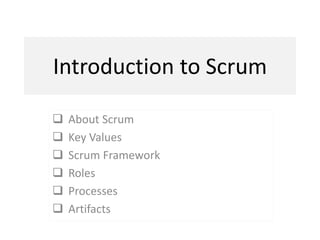Scrum Intro for E-works
- 1. Introduction to Scrum About Scrum Key Values Scrum Framework Roles Processes Artifacts
- 2. Agile Manifesto • Individuals and interactions over processes and tools • Working software over comprehensive documentation • Customer collaboration over contract negotiation • Responding to change over following a plan
- 3. 12 principles 1. Our highest priority is to satisfy the customer through early and continuous delivery of valuable software. 2. Welcome changing requirements, even late in development. Agile processes harness change for the customer's competitive advantage. 3. Deliver working software frequently, from a couple of weeks to a couple of months, with a preference to the shorter timescale. 4. Business people and developers must work together daily throughout the project.
- 4. 12 Princilpes 1. Build projects around motivated individuals. Give them the environment and support they need, and trust them to get the job done. 2. The most efficient and effective method of conveying information to and within a development team is face-to-face conversation. 3. Working software is the primary measure of progress. 4. Agile processes promote sustainable development. The sponsors, developers, and users should be able to maintain a constant pace indefinitely.
- 5. 12 Principles • Continuous attention to technical excellence and good design enhances agility. • Simplicity--the art of maximizing the amount of work not done--is essential. • The best architectures, requirements, and designs emerge from self-organizing teams. • At regular intervals, the team reflects on how to become more effective, then tunes and adjusts its behavior accordingly.
- 6. What is Scrum? o Agile way of Project Management o A team based- collaborative approach o Iterative & Incremental development o Focus to deliver “business value”
- 7. More about Scrum • Scrum is an agile process that allows to focus on delivering the highest business value in the shortest time. • It allows to rapidly and repeatedly inspect actual working software (every two weeks to one month). • The business sets the priorities. Teams self-organize to determine the best way to deliver the highest priority features. • Every two weeks to a month anyone can see real working software and decide to release it as is or continue to enhance it for another sprint.
- 8. Key Values oSimplicity is Essential (the power of less) oSelf-organizing teams oCommunication is the key oDeliver Frequently
- 9. Scrum Framework • Roles -Product owner -Project Manager/ Scrum Master -Team • Ceremonies -Sprint Planning -Sprint Review -Sprint Retrospective -Daily Scrum meeting • Artifacts -product backlog -sprint backlog -burn-down charts
- 10. Roles • Product owner • Project Manager/ Scrum Master • Team
- 11. Product Owner o Define the features of the product o Decide on release date and content o Be responsible for the profitability of the product (ROI) o Prioritize features according to market value o Adjust features and priority every iteration, as needed o Accept or reject work results
- 12. Project Manager ( Scrum Master) o Represents management to the project o Responsible for enacting Scrum values and practices o Removes impediments o Ensure that the team is fully functional and productive o Enable close cooperation across all roles and functions o Shield the team from external interferences
- 13. The Team • Typically 3-9 people • Cross-functional: • Programmers, testers, user experience designers, etc. • Members should be full-time • May be exceptions (e.g., database administrator)
- 14. Sprint retrospective CEREMONIES • Sprint planning • Sprint review • Sprint retrospective • Daily scrum meeting
- 15. Sprint planning o Team selects items from the product backlog they can commit to completing o Sprint backlog is created o Tasks are identified and each is estimated (1-16 hours) o Collaboratively, not done alone by the PM o High-level design is considered
- 16. Print Retrospectives o Periodically take a look at what is and is not working o Typically 15–30 minutes o Done after every sprint o Whole team participates o Project Manager o Product owner o Team o Possibly customers and others
- 17. The Daily Scrum o Parameters o Daily o 15-minutes o Stand-up o Not for problem solving o Whole world is invited o Only team members, project manager, product owner, can talk o Helps avoid other unnecessary meetings
- 18. The Sprint Review o Team presents what it accomplished during the sprint o Typically takes the form of a demo of new features or underlying architecture o Informal o 2-hour prep time rule o No slides o Whole team participates o Invite the world
- 19. Artifacts • Product backlog • Sprint backlog • Burn-down charts
- 20. Product Backlog o The requirements o A list of all desired work on the project o Ideally expressed such that each item has value to the users or customers of the product o Prioritized by the product owner o Reprioritized at the start of each sprint
